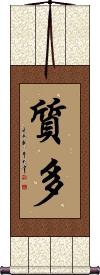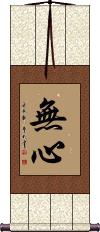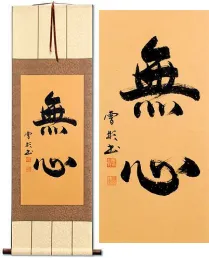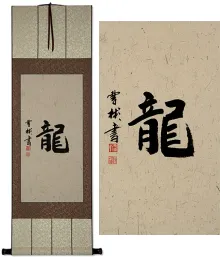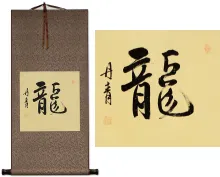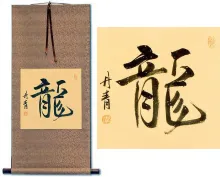Many custom options...
And formats...

Thinking Heart in Chinese / Japanese...
Buy a Thinking Heart calligraphy wall scroll here!
Personalize your custom “Thinking Heart” project by clicking the button next to your favorite “Thinking Heart” title below...
Thinking Heart
No Mind / Mushin
In Japanese, 無心 means innocent or without knowledge of good and evil. It literally means “without mind.”
無心 is one of the five spirits of the warrior (budo) and is often used as a Japanese martial arts tenet. Under that context, places such as the Budo Dojo define it this way: “No mind, a mind without ego. A mind like a mirror which reflects and dos not judge.” The original term was “mushin no shin,” meaning “mind of no mind.” It is a state of mind without fear, anger, or anxiety. Mushin is often described by the phrase “Mizu no Kokoro,” which means “mind like water.” The phrase is a metaphor describing the pond that clearly reflects its surroundings when calm but whose images are obscured once a pebble is dropped into its waters.
This has a good meaning in conjunction with Chan / Zen Buddhism in Japan. However, out of that context, it means mindlessness or absent-mindedness. To non-Buddhists in China, this is associated with doing something without thinking.
In Korean, this usually means indifference.
Use caution and know your audience before ordering this selection.
More info: Wikipedia: Mushin
This in-stock artwork might be what you are looking for, and ships right away...
Gallery Price: $202.00
Your Price: $111.88
Gallery Price: $202.00
Your Price: $111.88
Not the results for Thinking Heart that you were looking for?
Below are some entries from our dictionary that may match your Thinking Heart search...
| Characters If shown, 2nd row is Simp. Chinese |
Pronunciation Romanization |
Simple Dictionary Definition |
心 see styles |
xīn xin1 hsin shin しん |
More info & calligraphy: Heart / Mind / Spirit(1) (See 心・こころ・1) heart; mind; spirit; vitality; inner strength; (2) bottom of one's heart; core (of one's character); nature; (3) (usu. written as 芯) (See 芯・2) centre; center; core; heart; (4) (See 心臓・1) heart (organ); (5) {astron} (See 二十八宿) Chinese "Heart" constellation (one of the 28 mansions); (6) (archaism) (child. language) friend; (given name) Haato hṛd, hṛdaya 汗栗太 (or 汗栗馱); 紀哩馱 the heart, mind, soul; citta 質多 the heart as the seat of thought or intelligence. In both senses the heart is likened to a lotus. There are various definitions, of which the following are six instances: (1) 肉團心 hṛd, the physical heart of sentient or nonsentient living beings, e. g. men, trees, etc. (2) 集起心 citta, the ālayavijñāna, or totality of mind, and the source of all mental activity. (3) 思量心 manas, the thinking and calculating mind; (4) 緣慮心; 了別心; 慮知心; citta; the discriminating mind; (5) 堅實心 the bhūtatathatā mind, or the permanent mind; (6) 積聚精要心 the mind essence of the sutras. |
質多 质多 see styles |
zhí duō zhi2 duo1 chih to chitta |
More info & calligraphy: Thinking Heart |
十心 see styles |
shí xīn shi2 xin1 shih hsin jisshin |
The ten kinds of heart or mind; there are three groups. One is from the 止觀 4, minds ignorant and dark; affected by evil companions; not following the good; doing evil in thought, word, deed; spreading evil abroad; unceasingly wicked; secret sin; open crime; utterly shameless; denying cause and effect (retribution)―all such must remain in the flow 流 of reincarnation. The second group (from the same book) is the 逆流 the mind striving against the stream of perpetual reincarnation; it shows itself in devout faith, shame (for sin), fear (of wrong-doing), repentance and confession, reform, bodhi (i.e. the bodhisattva mind), doing good, maintaining the right law, thinking on all the Buddhas, meditation on the void (or, the unreality of sin). The third is the 眞言 group from the 大日經疏 3; the "seed" heart (i.e. the original good desire), the sprout (under Buddhist religious influence), the bud, leaf, flower, fruit, its serviceableness; the child-heart, the discriminating heart, the heart of settled judgment (or resolve). |
心態 心态 see styles |
xīn tài xin1 tai4 hsin t`ai hsin tai |
attitude (of the heart); state of one's psyche; way of thinking; mentality |
The following table may be helpful for those studying Chinese or Japanese...
| Title | Characters | Romaji (Romanized Japanese) | Various forms of Romanized Chinese | |
| Thinking Heart | 質多 质多 | chitta | zhí duō / zhi2 duo1 / zhi duo / zhiduo | chih to / chihto |
| No Mind Mushin | 無心 无心 | mu shin / mushin | wú xīn / wu2 xin1 / wu xin / wuxin | wu hsin / wuhsin |
| In some entries above you will see that characters have different versions above and below a line. In these cases, the characters above the line are Traditional Chinese, while the ones below are Simplified Chinese. | ||||
Successful Chinese Character and Japanese Kanji calligraphy searches within the last few hours...
